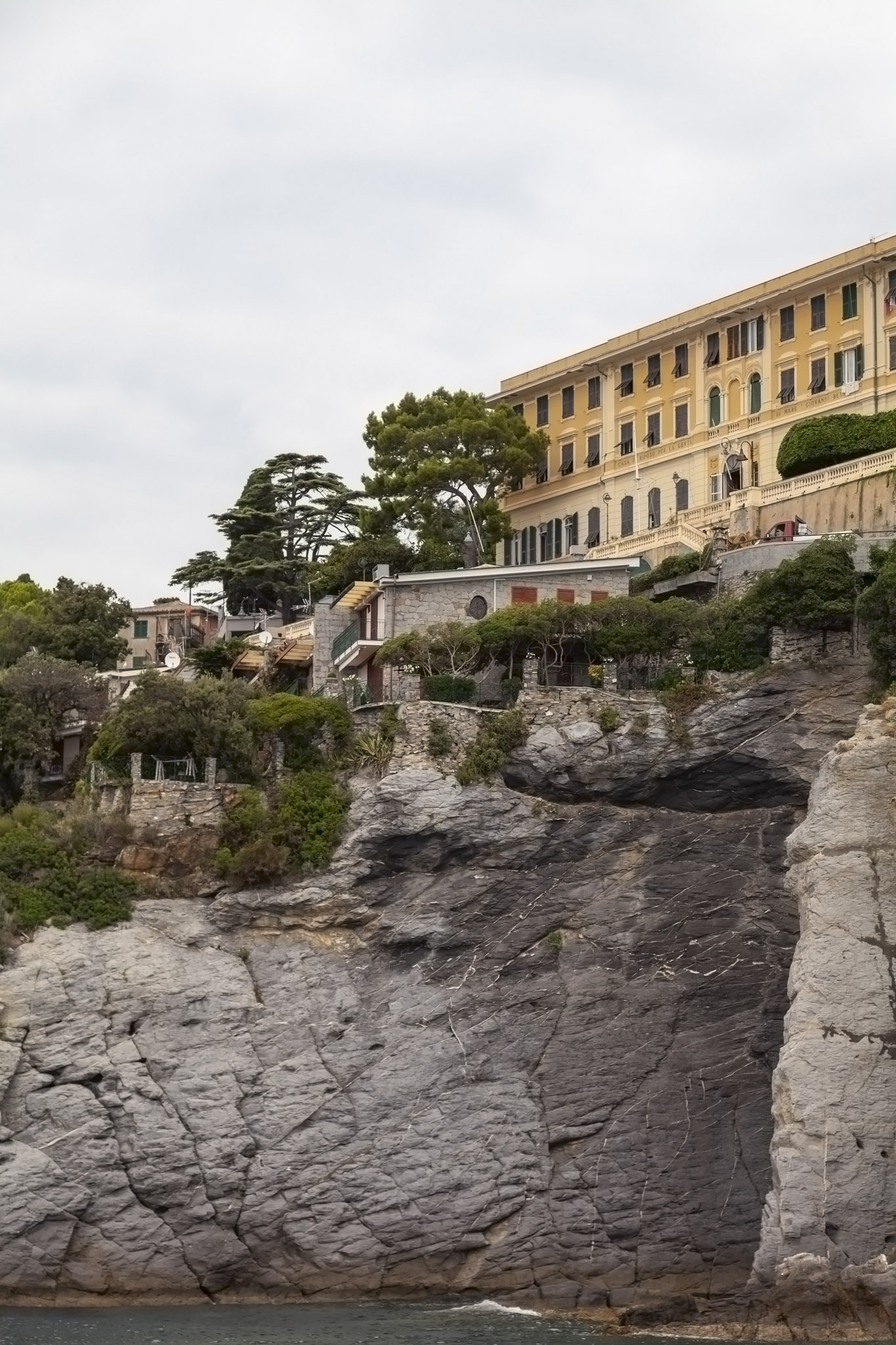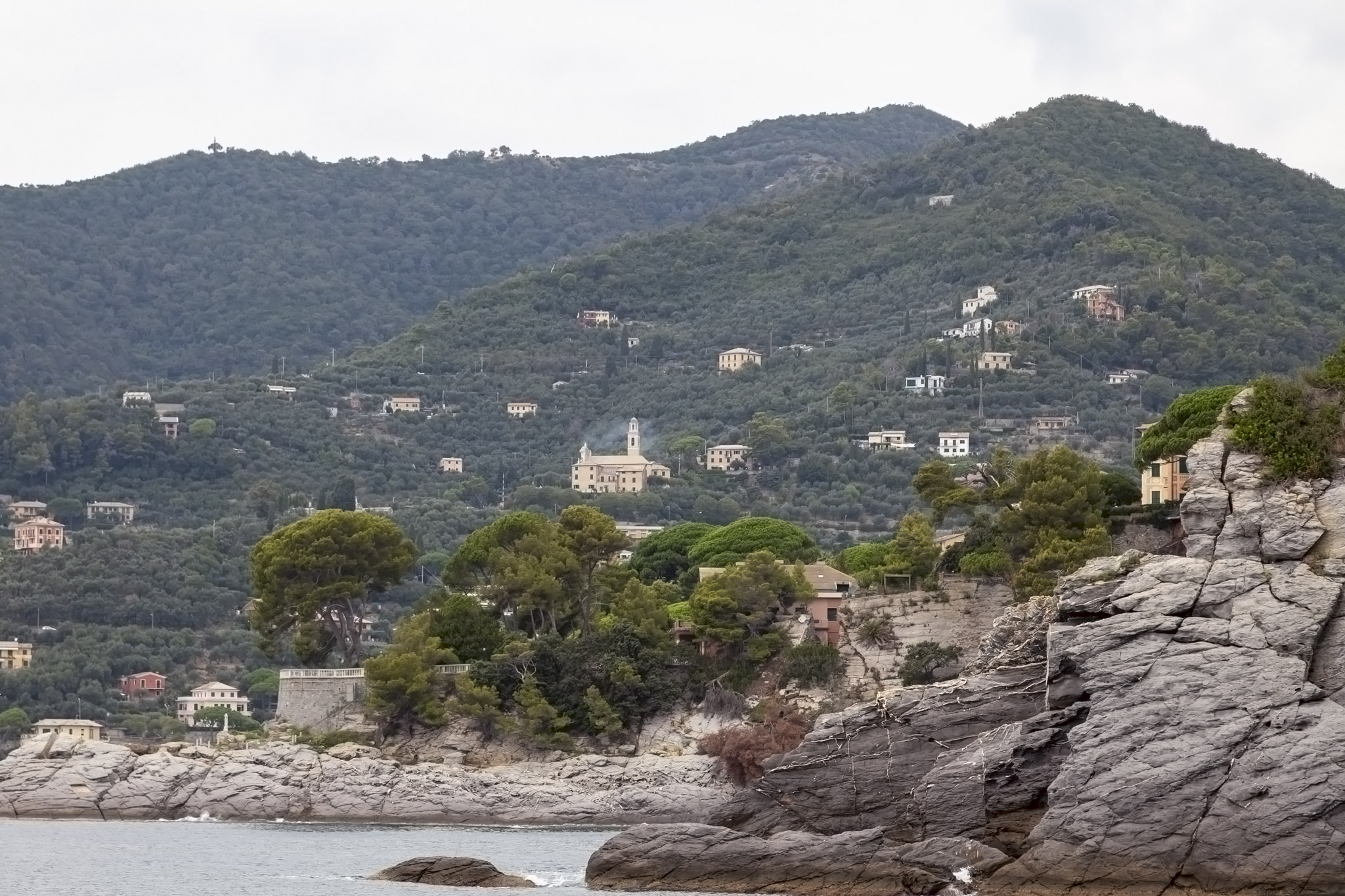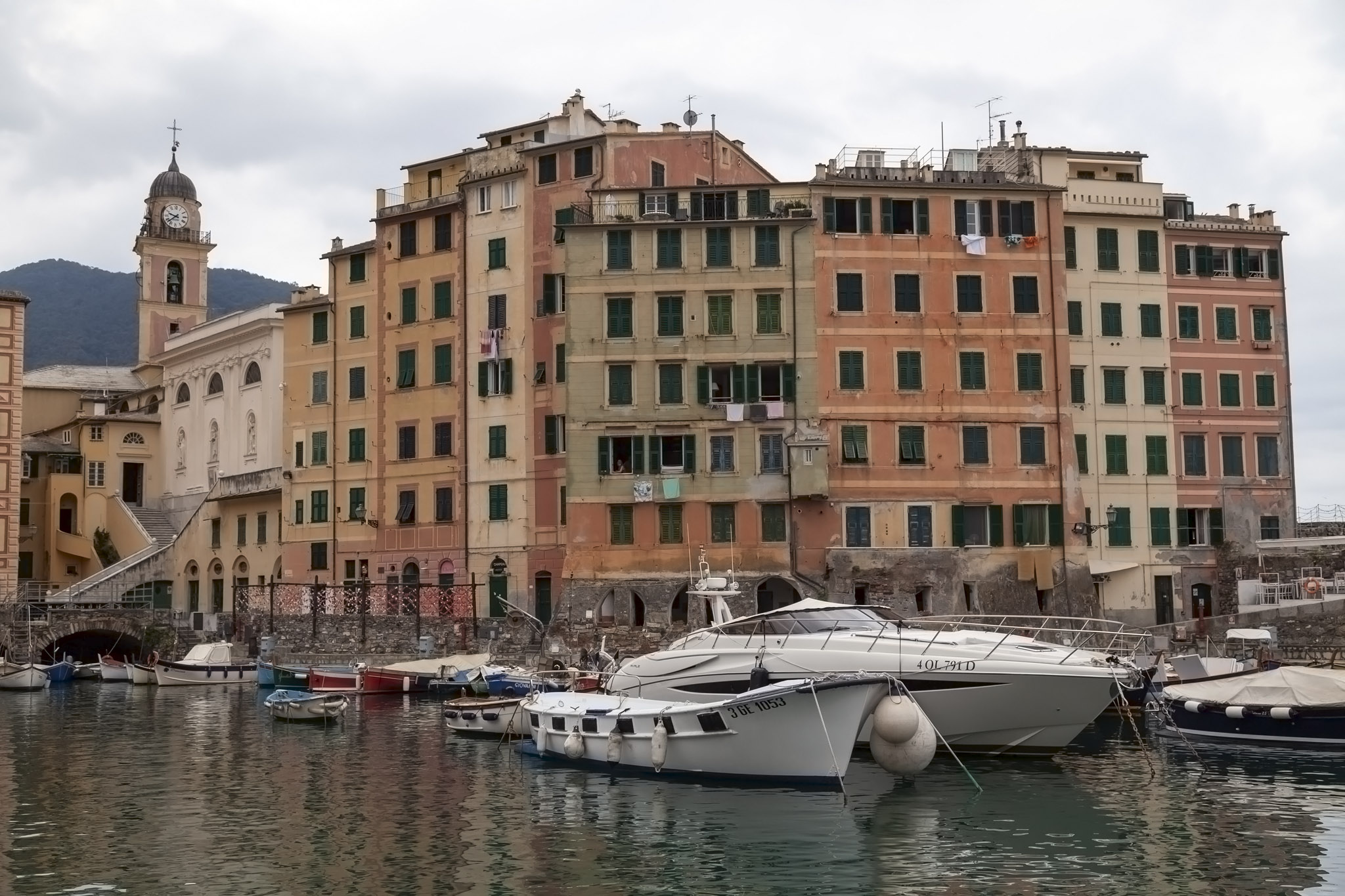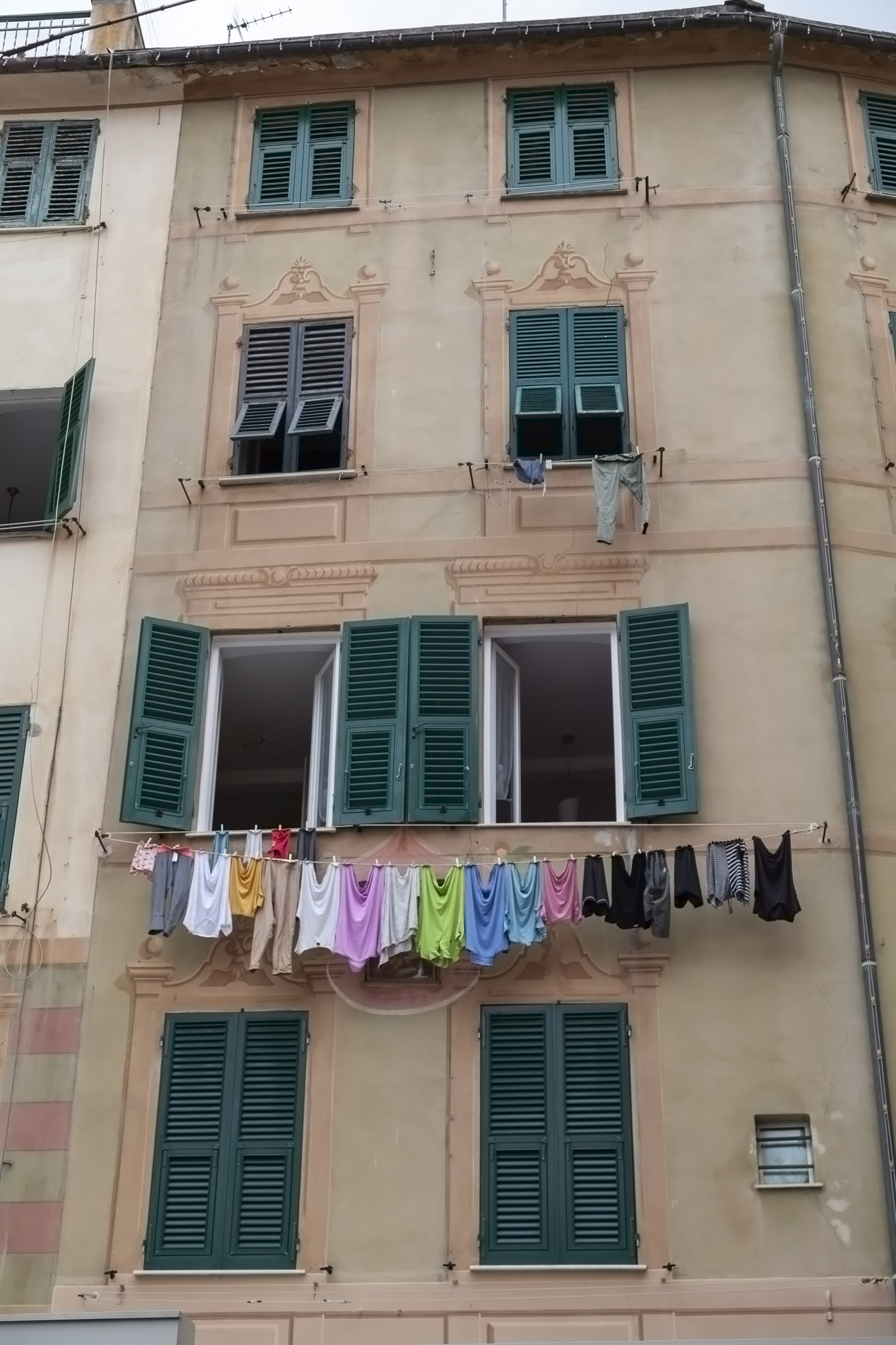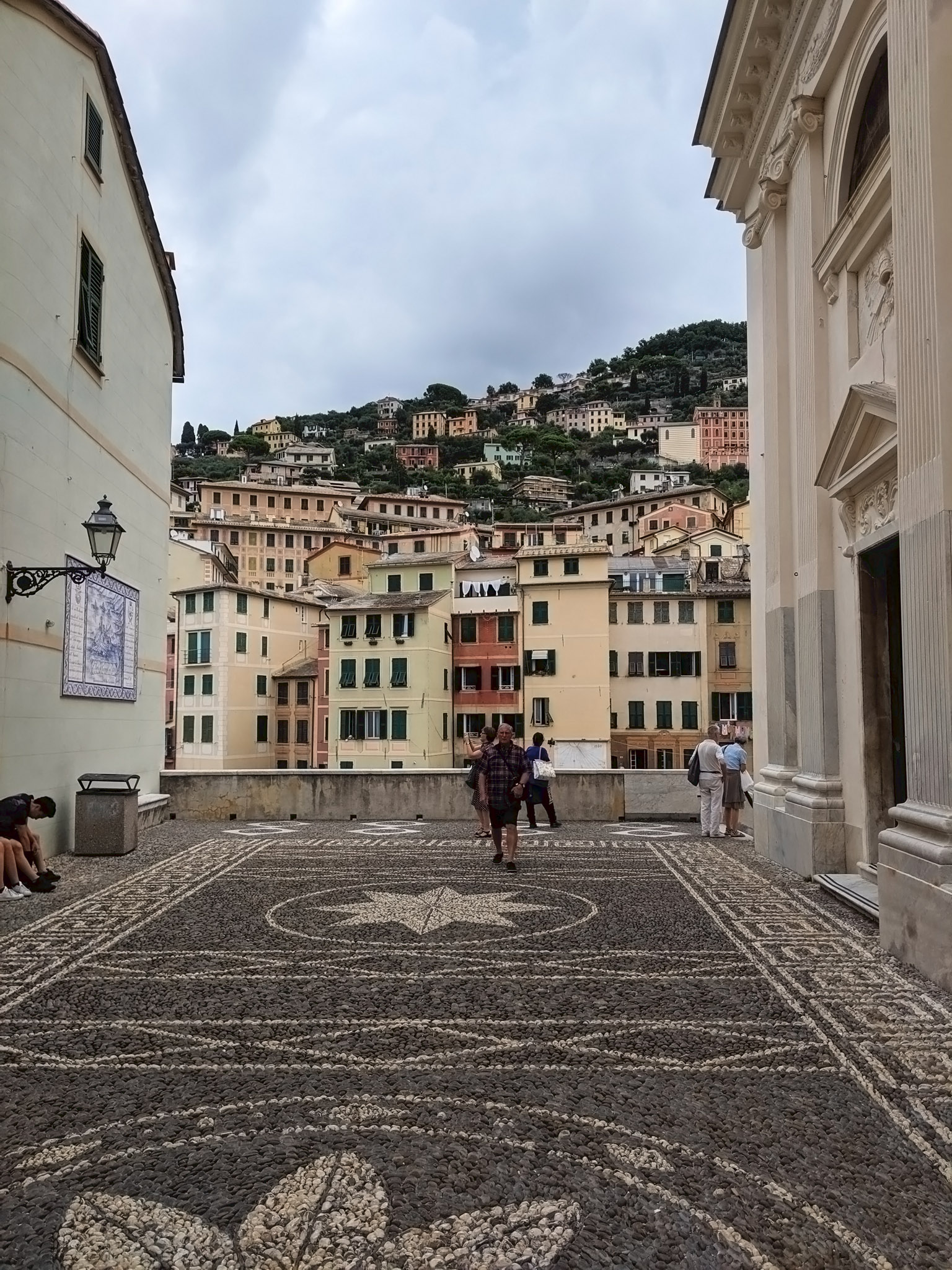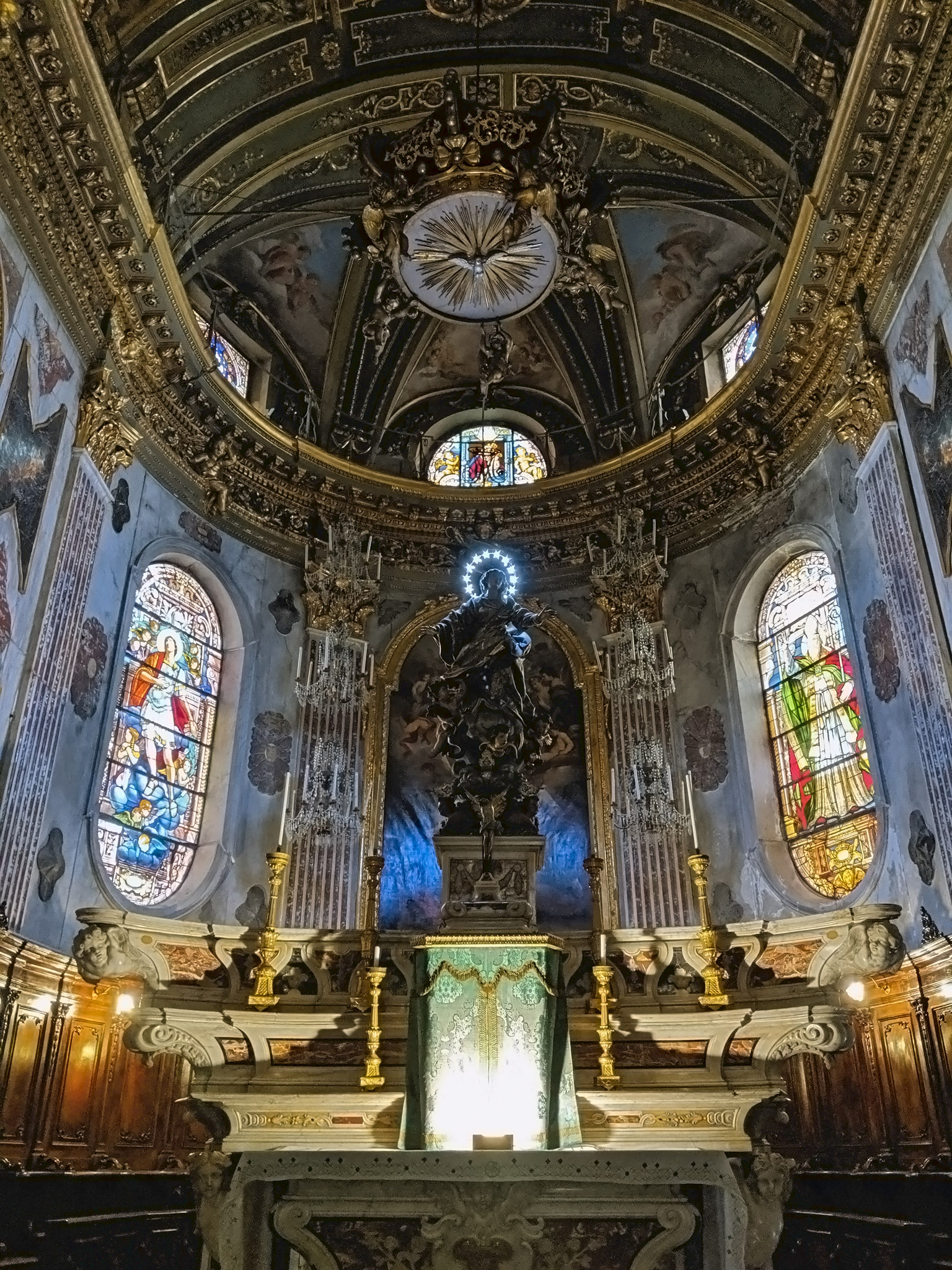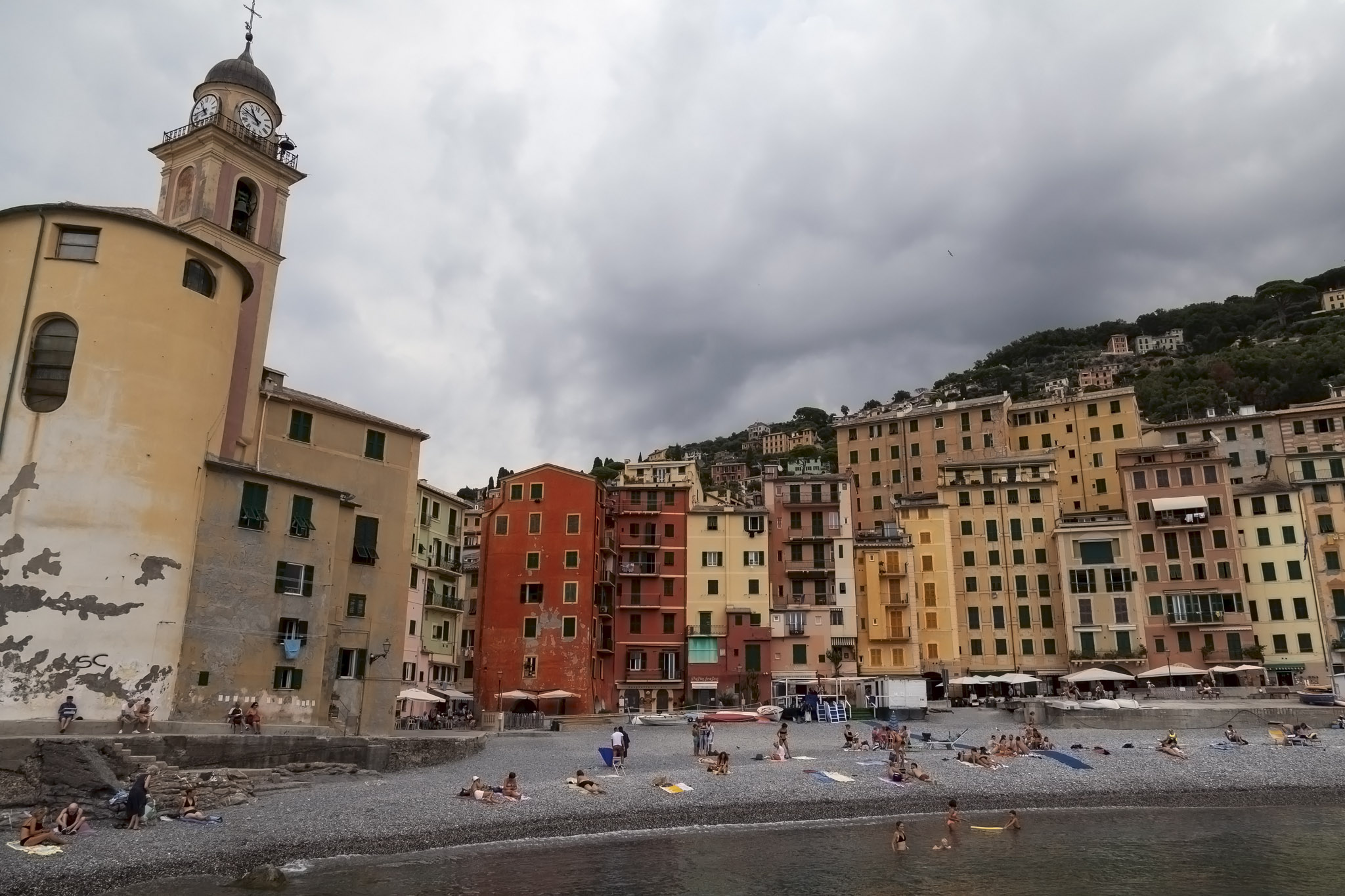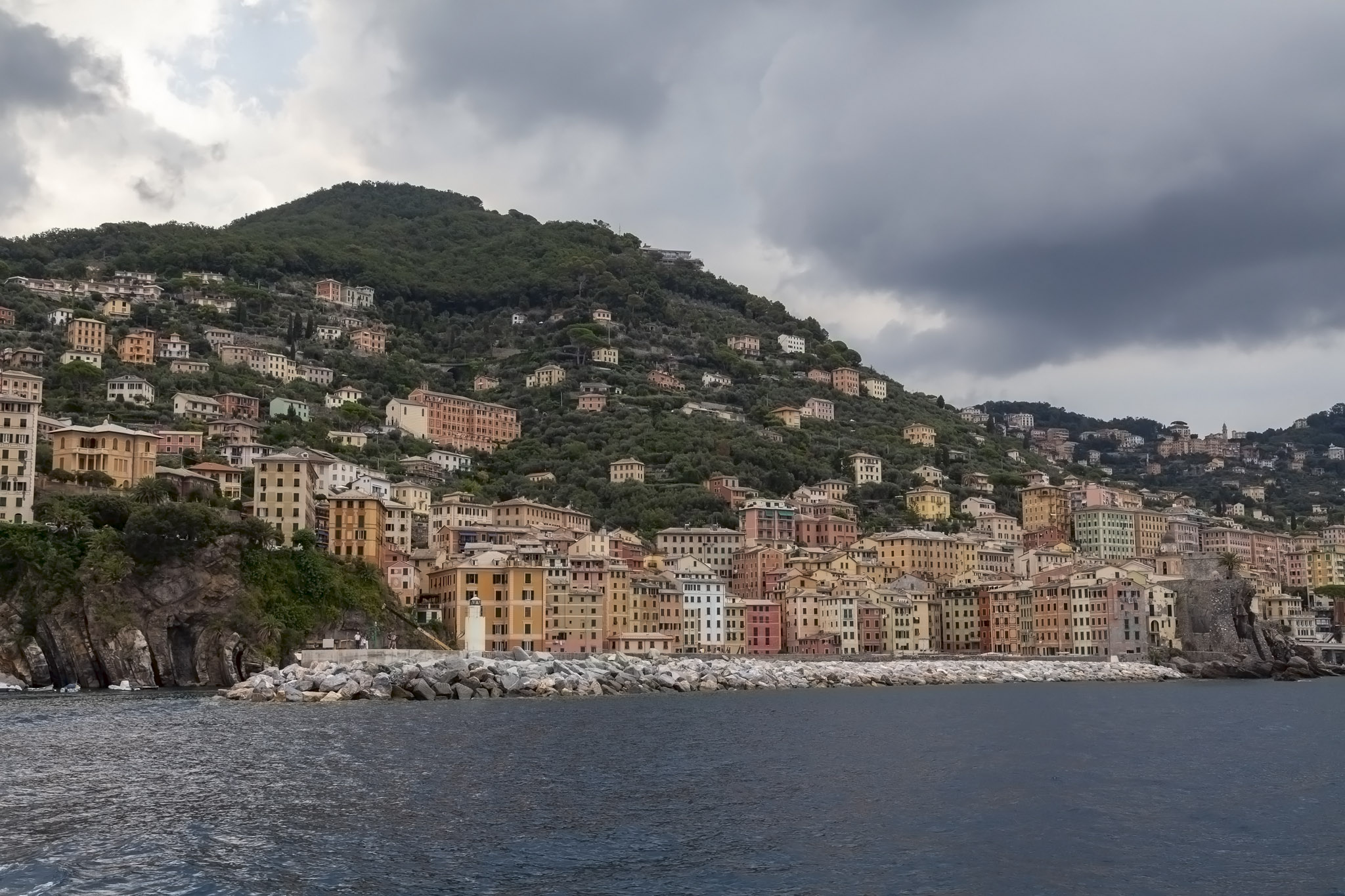We arrived at Camogli and since we were on a boat it was Camogli harbour to be more precise. Cliffs formed one side of the harbour entrance while stone foundations on which large buildings had been erected made up the other two sides of this most attractive way to visit the coastal fishing village.
If you’ve been following along with the cruise and this excursion in particular so far then you’ll know that our boat ride from Genoa along the Ligurian coastline had been accompanied by numerous towns and villages along the hills, beaches, and cliffs we passed, mostly sharing that range of colours you seem to find in central and northern Europe. Not so much in the UK or in the warmer, southern reaches of the continent for some reason. I don’t know why that is. Camogli’s houses had that same colourful look to some extent although the range was weighted heavily towards yellows and pinks with far fewer of the blues and greens you often see elsewhere.
The harbour told us a lot about Camogli that was probably also being explained by our tour guide but which I wasn’t paying attention to and that was that this was a fishing village first and a tourist destination second to that. That may be still true – it certainly is the case that it was; in an 1880 census nearly 5% of the population were registered as captains of vessels – but tourism plays more and more a part these days for the local economy and Camogli is being discovered by more foreign visitors to Italy when it’s previously been a little-known secret for locals.
If you’ve been on a cruise excursion before then you know the drill; you turn up at the place you’re meant to meet when you’re due to, you get assigned a group number, you wait to be called then hop on the bus for your group. This, though, was a boat tour and not a bus tour and the boat was large enough to get everyone aboard at once so there had been three groups of us on the vessel that arrived in Camogli. As we disembarked we regrouped according to our assigned number once more and each headed off with its guide to be shown different points of interest in the fishing village in an order prearranged so that the entire boat’s capacity wasn’t trying to see the same thing at the same time. You can see the common sense in this approach when you see the narrowness of the alleys between the buildings surrounding the harbour area below. This is where our group was initially taken in order to see the compact nature of the village, the height of the buildings, and the religious shrines decorated with shells – families praying for their loved ones to return safely from sea – which reminded us a little of the common shell motifs in Santiago de Compostela as well as Margate. Those are some pretty diverse locations of which to be reminded.
That little diversion into the narrow confines of Camogli’s alleys gave enough time for whichever group had met in the main square in front of the harbour to move on so we emerged from the darkness and Instagram-worthy steps (well, one couple in our group thought so; classic photos of her facing away, angled head, playing with hair, clichés dripping all over the treads and risers, that sort of thing) and back into the light of the Piazza Cristoforo Colombo. This was the open square area right at the harbour entrance and other than providing pleasing views of the water and boats therein as well as being bordered by several charming-looking cafés and drinking establishments, also sported a decorative stone pattern on the ground made from black and white pebbles and in the form of a compass rose. We would see more of these decorations during our excursion along the Ligurian coast.
In fact, we saw another decorative pattern made from black and white stones almost immediately as we were taken up a set of steps to the exterior of the Basilica di Santa Maria Assunta. The pebbled mosaics are called Risseu, the Genoese name for pebbles, and they are a very typical design of the Ligurian region dating to around the seventeenth century but with origins far older than that, some people maintaining they can be traced to Mesopotamian cultures while others assume they are more likely equivalents of Roman mosaics instead. They’re quite striking and very pretty.
A minor basilica now, thanks to Pope John Paul II, but originally just a parish church erected in the twelfth century on the rocky peninsula of Camogli, the interior of the structure came as quite a shock. Rather drab, weather-worn walls outside were replaced with very ornately decorated ones inside in a typically baroque style. Gold and marble was in abundance as you can see from the photos below.
Opposite the entrance to the church was a tiled decoration for the rocky islet attached to the mainland on which we were standing. Adjacent to the church was Castle Dragonara which either sounds like a terrifying beast of legend or a type of pasta sauce depending on how your mind works but which was named for neither of those things. In addition to being used for defensive purposes and sanctuary during pirate attacks the castle had also served as the meeting place to elect town leaders and during the 1970s housed an aquarium. We didn’t go in but instead clambered around its exterior for some lovely views out to sea and back across to the beach of Camogli and the tall, colourful building façades back from the shoreline.
We had some free time then to explore Camogli on our own before meeting up to get some focaccia. Each of the three groups had been allocated a time in which to see focaccia being made and to have a tasting with some wine with one group doing it as soon as we’d arrived, the second group doing it in the middle of the visit to the village, and our group doing it at the end.
Our guide gave us some general advice about what to see or do on our own which basically amounted to “You can’t really get lost because this place is small, there are plenty of cafés along the seafront, and in that direction is a giant frying pan.” A giant frying pan, you say? Guess where we headed.
An easy stroll along the promenade set back and above Camogli’s beach saw us pass some attractive, flowering cacti and presented numerous lovely views outwards and back the way we’d come even on an overcast day like this. Only one other couple from our group wandered along with us and that was Mr and Mrs Instagram All The Things. They’d stride ahead, pose ridiculously for photos as we ambled past, then they’d rush past us again for the next one. They did provide some mild entertainment.
In case you’re worried that you might miss the giant frying pan in Camogli then rest assured that you can’t miss the giant frying pan in Camogli.
Every year on the second Sunday in May – a tradition that started in 1952 – the Piazza Cristoforo Colombo (where we’d disembarked from our boat) becomes the site of the Sagra del Pesce fish festival. A giant pan is used to cook fish for the locals with money raised going to charity. The pan weighs around 28 tons and its total length is ten metres. The one on the wall that we’d come to see was one of the earlier pans used and isn’t the one used annually.
Beyond the pan to the south of the main beach area of Camogli there didn’t look like there was much more that was interesting and we didn’t want to head too far away from where we’d need to meet up for our food and drink as that would require a faster pace of walking. We don’t do fast walking paces. We’re on holiday, darling. We turned back here. The wall of one of the buildings we’d passed by caught my eye as I noticed a lot of trompe-l’œil designs on it and I was reminded of our visit to Arles the day before. We would end up seeing walls decorated like this several more times along the Mediterranean coast during our cruise and can only assume that seagulls flying into houses is a major problem in the region requiring the use of decoy windows to stun the birds and encourage them to remain outside.
We retraced our steps back into the heart of Camogli, a short journey thanks to the small size of the fishing village and one that made us wonder just what this place must have looked like in 1797. At that time Camogli had been under the rule of Napoleon and the place had hosted a large contingent of his fleet in addition to hundreds of tall ships, and it was hard to picture the scene from what we could see. It was a lot easier to imagine the scene in 1798 as those naval vessels had been captured or destroyed in the Battle of the Nile by Nelson. We always like stumbling on places with tenuous connections to our home city of Portsmouth.
We had a little bit of time to kill before our focaccia-making demonstration so I dragged my wife out onto the short, concrete jetty projecting from the peninsula hosting Camogli’s basilica and castle. This gave me a chance to take some photos of the buildings around the shore and the beach itself from a slightly different angle and also satisfied some perverse desire I have to always find a way to get out over the water somewhere when we’re travelling (see: all the times we find ourselves on piers).
You’ll notice that the beach is rather grey and lacking sand and if you’re the sort of person who only adores a golden stretch of shoreline then it probably doesn’t look too appealing. Pebbles are clearly a widely available natural resource in the region and it’s likely for that reason that they are used so much in the decorative patterns we’d already encountered. Personally, we’ve no problem with stony beaches simply because where we live that’s all you get too, although with some more variation in the colour and a generally warmer look. I was amused to read a local guide’s description of this beach, though, translated from Italian:
Burning pebbles optimistically defined as a beach. In the middle of the bathing season, they are stacked one on top of the other as intensive breeding chickens. Absolutely to be avoided. If you want to take a bath, use the tub of your home, throw two stones on the floor, turn on the oven and point to a 1000w halogen lamp in the face. The effect is identical.
This then brought us to the time for our focaccia experience. Focaccia is big business in Camogli. If you’ve been paying attention to any of the buildings in the photographs so far you might have seen the odd one or two or three or more focaccerias; you’d have to be supremely unlucky to miss one if you were visiting this village. If you’re still not convinced that Camogli likes focaccia then this piece of artwork near the piazza might persuade you.
The location for our focacceria demonstration was off one of the narrow alleys connecting the beach area to the harbour area just east of the rocky peninsula. The kitchen was too small to get everyone in at once so we took turns with about eight at a time squeezing into the very, very hot environment to watch the focaccia makers do their stuff. You can see some of that in the video at the end of the post. As we rotated out of the kitchen we then walked a few doors down to a café where focaccia and a glass of local white wine was laid on. I’ll note here that there were a number of high steps to ascend into the café and the seating area at its rear that caused some problems for at least one person in our group who had walking difficulties so bear that in mind.
That was our first experience eating focaccia and it was good; I wouldn’t say outstanding, but it was nice to have done it. We always like to eat and drink locally when we’re travelling.
All that remained was to head back to the piazza by the harbour and wait for the rest of our group and the other two groups to gather and board the boat for the next portion of our excursion along the Italian coast. I had enough time to grab some more photos which will come as a surprise to literally nobody in this universe.
If you were visiting Camogli you wouldn’t need a whole lot of time here to see all it had to offer but it had a very appealing, very relaxing charm to it and would make a great base for exploring the region especially as its mostly western-facing location should produce plenty of opportunities to watch the sun go down with some Italian food and wine to enjoy and only the occasional thump of seagulls careening into painted walls to break up the gentle lapping of the waters on the pebbled beach.
This video (temporarily removed) includes highlights of Camogli from our visit, including views of the beach and of the basilica and castle plus the focaccia-making experience and some footage of our boat’s departure from Camogli harbour then back out into the Mediterranean Sea.
In the next post in this cruise travelogue series I’ll cover the second of the three stops we had on this boat trip, that being a visit to Santa Margherita Ligure.


